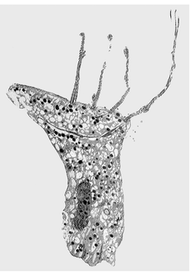New features for inferring relationships among planktonic ciliates (unicellular organisms)
FWF-Projekt P28790  Ciliates are heterotrophic unicellular organisms of microscopic size (< 1 mm). Currently, we know about 4,500 species, apparently only a small fraction (~ 20%) of the real diversity. The Oligotrichea (ancient Greek “the sparsely ciliated ones”) are typical planktonic organisms, especially of the sea. They comprise about 190 naked species and approximately 1000 house-forming tintinnid species.
Ciliates are heterotrophic unicellular organisms of microscopic size (< 1 mm). Currently, we know about 4,500 species, apparently only a small fraction (~ 20%) of the real diversity. The Oligotrichea (ancient Greek “the sparsely ciliated ones”) are typical planktonic organisms, especially of the sea. They comprise about 190 naked species and approximately 1000 house-forming tintinnid species.
Oligotrichea are an essential component of the marine food web: the globular or conical organisms swim by means of their minute ciliary fans at the apical cell end in the water column and filter huge amounts of bacteria and other unicellular organisms, e.g., algae. They are preyed upon by small crustaceans, the food of many fish larvae. In the past 20 years, morphologic and genetic analyses contributed greatly to the discovery of new species and the elucidation of relationships among the Oligotrichea.
The genetic data, however, occasionally indicate relationships that are not in accordance with the overall morphology, especially of the tintinnid houses. Therefore, (new) cell features are required to reconcile the morphology-based relationship hypotheses with the gene tree topologies. The almost unexplored ultrastructure, which can be studied by means of ultrathin (0.00007 mm) transverse and longitudinal sections of the cell in the transmission electron microscope, promises many new characters. Beyond the descriptions of new and the redescriptions of insufficiently known species in the frame of the project, the phylogenetic relationships among Oligotrichea are studied for the first time, using ultrastructural features.
Accordingly, this innovative and synergistic approach combines live observation, the investigation of stained material (e.g., revealing the species-specific ciliary patterns), electron microscopical data, and genetic analyses. In doing so, the project elucidates not only the relationships among the Oligotrichea, but also provides novel insights into general evolutionary principles in protists and the evolution of diversity in unicellular organisms. Particularly, the potential morphologic adaptations in the organisms related to the transition to freshwater and a nutrition mode combining feeding and photosynthesis are in the focus of the present study.
The expertise to identify and describe species has become almost extinct in Europe and the USA; yet, it is indispensable for ecological studies and barcoding. This fast and comparatively inexpensive method shall permit even non-specialists the identification of specimens by the comparison of small gene sequences. To be routinely employable, the method, however, necessitates a reliable determination of the reference specimens by experts prior to their genetic analyses.As part of the project, master students and a doctoral student are trained in the whole spectrum of morphologic and genetic investigation methods; so, they become experts in this speciose group of unicellular organisms.




